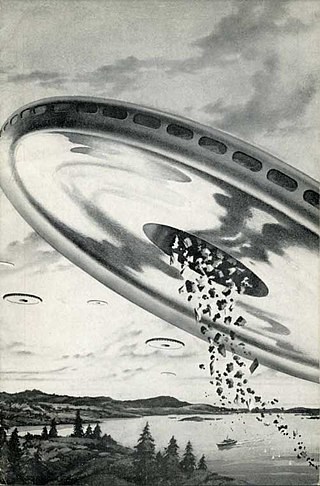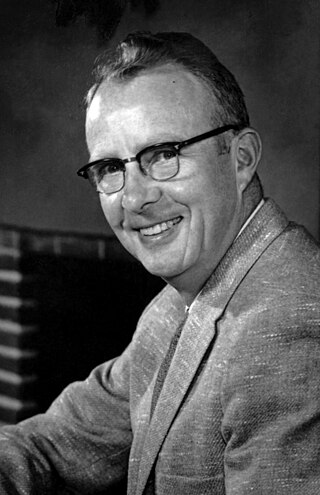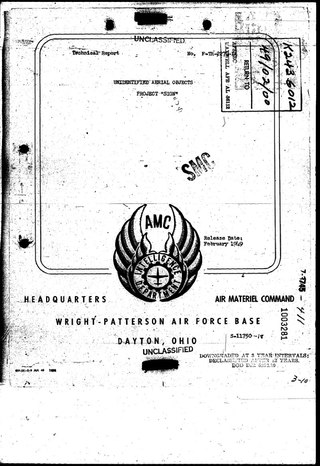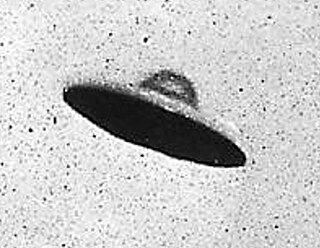
An unidentified flying object (UFO), or unidentified anomalous phenomenon (UAP), is any perceived airborne, submerged or transmedium phenomenon that cannot be immediately identified or explained. Upon investigation, most UFOs are identified as known objects or atmospheric phenomena, while a small number remain unexplained.

Project Blue Book was the code name for the systematic study of unidentified flying objects by the United States Air Force from March 1952 to its termination on December 17, 1969. The project, headquartered at Wright-Patterson Air Force Base, Ohio, was initially directed by Captain Edward J. Ruppelt and followed projects of a similar nature such as Project Sign established in 1947, and Project Grudge in 1949. Project Blue Book had two goals, namely, to determine if UFOs were a threat to national security, and to scientifically analyze UFO-related data.
On 7 January 1948, 25-year-old Captain Thomas F. Mantell, a Kentucky Air National Guard pilot, died when he crashed his P-51 Mustang fighter plane near Franklin, Kentucky, United States, after being sent in pursuit of an unidentified flying object (UFO). Mantell pursued the object in a steep climb and disregarded suggestions to level his altitude. At high altitude, he blacked out from a lack of oxygen; his plane went into a downward spiral and crashed. The incident was among the most publicized of early UFO reports. Later investigation by the United States Air Force's Project Blue Book indicated that Mantell died chasing a Skyhook balloon, which, in 1948, was a top-secret project that he would not have known about.
The extraterrestrial hypothesis (ETH) proposes that some unidentified flying objects (UFOs) are best explained as being physical spacecraft occupied by extraterrestrial intelligence or non-human aliens, or non-occupied alien probes from other planets visiting Earth. In spite of ardent believers that various UFO sightings are verifiable evidence for the hypothesis, no rigorous analysis has ever concluded as much.

The Maury Island incident refers to claims made by Fred Crisman and Harold Dahl of falling debris and threats by men in black following sightings of unidentified flying objects in the sky over Maury Island, Washington, United States. The pair claimed that the events had occurred on June 21, 1947. The incident is widely regarded as a hoax, even by believers of flying saucers and UFOs.

The Flying Saucers Are Real, by Donald Keyhoe, is a book that investigated reports of UFOs by United States Air Force fighters, personnel, and other aircraft, between 1947 and 1950.

The Robertson Panel was a scientific committee which met in January 1953 headed by Howard P. Robertson. The Panel arose from a recommendation to the Intelligence Advisory Committee (IAC) in December 1952 from a Central Intelligence Agency (CIA) review of the U.S. Air Force investigation into unidentified flying objects, Project Blue Book. The CIA review itself was in response to widespread reports of unidentified flying objects, especially in the Washington, D.C. area during the summer of 1952.
The Lubbock Lights were an unusual formation of lights seen over the city of Lubbock, Texas in August and September 1951. The Lubbock Lights incident received national publicity in the United States as a UFO sighting, and was investigated by the U.S. Air Force. According to Captain Edward J. Ruppelt, "Officially all of the sightings, except the UFO that was picked up on radar, are unknowns."

Edward James Ruppelt was a United States Air Force officer probably best known for his involvement in Project Blue Book, a formal governmental study of unidentified flying objects (UFOs). He is generally credited with coining the term "unidentified flying object", to replace the terms "flying saucer" and "flying disk" – which had become widely known – because the military thought them to be "misleading when applied to objects of every conceivable shape and performance. For this reason the military prefers the more general, if less colorful, name: unidentified flying objects. UFO for short."

The Condon Committee was the informal name of the University of Colorado UFO Project, a group funded by the United States Air Force from 1966 to 1968 at the University of Colorado to study unidentified flying objects under the direction of physicist Edward Condon. The result of its work, formally titled Scientific Study of Unidentified Flying Objects, and known as the Condon Report, appeared in 1968.

Project Sign or Project Saucer was an official U.S. government study of unidentified flying objects (UFOs) undertaken by the United States Air Force (USAF) and active for most of 1948. It was the precursor to Project Grudge.

Project Grudge was a short-lived project by the U.S. Air Force (USAF) to investigate unidentified flying objects (UFOs). Grudge succeeded Project Sign in February, 1949, and was then followed by Project Blue Book. The project formally ended in December 1949, but continued in a minimal capacity until late 1999.
The Chiles-Whitted UFO encounter occurred at approximately 2:45 AM on July 24, 1948, in the skies near Montgomery, Alabama, United States. Two commercial pilots, Clarence S. Chiles and John B. Whitted, claimed to have observed a "glowing object" pass by their plane before it appeared to pull up into a cloud and travel out of sight.

From July 12 to 29, 1952, a series of unidentified flying object (UFO) sightings were reported in Washington, D.C., and later became known as the Washington flap, the Washington National Airport Sightings, or the Invasion of Washington. The most publicized sightings took place on consecutive weekends, July 19–20 and July 26–27. UFO historian Curtis Peebles called the incident "the climax of the 1952 (UFO) flap"—"Never before or after did Project Blue Book and the Air Force undergo such a tidal wave of (UFO) reports."

The McMinnville UFO photographs were taken on a farm near McMinnville, Oregon, United States, in 1950. The photos were reprinted in Life magazine and in newspapers across the nation, and are often considered to be among the most famous ever taken of a UFO. UFO skeptics have concluded that the photos are a hoax, but many ufologists continue to argue that the photos are genuine, and show an unidentified object in the sky.
The Gorman dogfight was a widely publicized UFO incident which took place on 1 October 1948, in the skies over Fargo, North Dakota, United States. United States Air Force (USAF) Captain Edward J. Ruppelt wrote in his bestselling and influential The Report on Unidentified Flying Objects that the "dogfight" was one of three "classic" UFO incidents in 1948 that "proved to [Air Force] intelligence specialists that UFOs were real," along with the Chiles-Whitted UFO encounter and the Mantell UFO incident. In 1949, the official explanation made by the USAF was that the Gorman dogfight had been caused by a lighted weather balloon.

On June 24, 1947, private pilot Kenneth Arnold claimed that he saw a string of nine, shiny unidentified flying objects flying past Mount Rainier at speeds that he estimated to be at least 1,200 miles per hour (1,900 km/h).
UFO is a 1956 American semi-documentary about the development of the UFO phenomenon in the United States. Clips from the documentary have often been used in other UFO documentaries and television episodes related to UFOs.

The Report on Unidentified Flying Objects is a 1956 book by then-retired Air Force UFO investigator Edward J. Ruppelt, detailing his experience running Project Blue Book. The book was noted for its suggestion that a few UFO sightings might be linked to spikes of atomic radiation. Contemporary media summarized four topics discussed in the book:

The Passaic UFO photographs are a set of photographs purportedly taken in Passaic, New Jersey by George Stock on July 31, 1952. Allegedly depicting a domed flying saucer, the images were widely published in contemporary media. Ufologist Kevin D. Randle called the Passaic photos the "most spectacular" of the 1952 flap but characterized them as a hoax.













